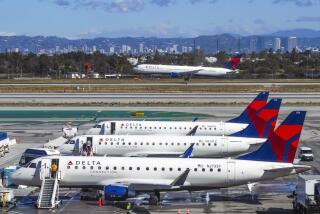Delta Charts New European Course : Aviation: Airline hopes suave British marketing expert can turn around the money-losing transatlantic operation it took over from Pan Am.
- Share via
NEW YORK — At Delta Air Lines Inc., Chairman Ron Allen’s southern drawl, simple suits and predictable neckties are standard. Most of his lieutenants are longtime loyalists who call him Ron.
So who’s the guy with a British accent who addresses Allen as “Mr. Chairman,” never worked at an airline before, and wears the loud, double-breasted pin stripe with a bright red hankie peeking out of the pocket?
“Now there’s a European suit. . . . That’s just what we were looking for,” one conservatively dressed Delta executive said quietly as Michael Medlicott entered a recent press conference in New York.
Delta wanted more than just another suit when it hired away the head of the British Tourist Authority this spring as vice president for its money-losing operation in Europe, far removed from the airline’s Atlanta home base.
Medlicott, 50, is an outsider in a company long known for promoting insiders to top positions. The corporate culture suggests he will never fit in.
But there was an acute lack of executives at Delta who knew how to do business in Europe after the airline bought Pan Am’s transatlantic routes and Frankfurt hub two years ago.
Delta is so eager to improve on the disappointing foray into Europe that it might adjust to Medlicott’s European ways and judge him on results.
“It’s indicative of how seriously they needed not only the right person but substantial changes,” said Tom Longman, an airline securities analyst at Bear Stearns & Co., a New York investment firm.
Delta also has retained management consultants McKinsey & Co. to study its European business. The firm is due to report back later this month or in early November. In the meantime, the airline has been cutting costs in Europe and reducing spending on new jets.
The key to improving Delta’s performance in Europe is luring back business travelers who have defected to other airlines, particularly since Pan Am’s preeminence as the American-European air connection unraveled in the 1980s.
Medlicott said he sees his mission as “determining what the business consumer wants . . . making sure we have the right product at the right price at the right time . . . and presenting Delta in a stylish, arresting, contemporary way.”
If the airline can’t build its brand reputation, the alternative is competition on schedule and price alone--a lesson Delta learned in the U.S. fare wars that it must avoid in Europe, he said.
With his marketing background at the British Tourist Authority and as senior manager of P&O; Cruises, a luxury ship line, Medlicott says he is confident he can sell Europeans on Delta.
He has already scored a victory by enticing the British Olympic Assn. to use Delta, rather than British Airways, to fly athletes to the 1996 Olympic Games in Atlanta.
“Whether you’re marketing autos, elevators or airline seats, marketing is a transferable art,” he said in a telephone interview from his London office. “It’s the same whether you’re running a candy store or a little piece of an airline.”
This particular piece of Delta was supposed to vault the historically cautious company into the big leagues of global aviation, but so far it has been a drag on profits.
Passenger traffic is beginning to pick up, but fare discounts are eroding the effects of improved revenue. In addition, Delta’s rivals aren’t competing just on price.
Lufthansa German Airlines, for example, is forming an alliance with United Airlines, which is surpassing American as the largest U.S. airline. As liberalization spreads through Europe, more airlines are expected to merge or form alliances, presenting bigger competitors to airlines like Delta.
“We’ll have to be more aggressive in the marketplace,” Allen said recently. “We’ll have sales and marketing people on the street trying to secure more business.”
The European business has been losing money since Delta bought the operation. Delta’s summer-quarter financial results, due later this month, are expected to reflect further hemorrhaging in Europe.
In taking ownership of Pan Am routes and terminals, Delta felt a little like a new homeowner who finds the dream house is a money pit.
The ceiling leaked at the Pan Am terminal at New York’s John F. Kennedy International Airport. Storage space on some old Pan Am jets was so tight that passenger luggage shared space with first-class china in overhead bins.
By then, many U.S. business travelers already had become so disaffected with Pan Am that the Delta takeover meant nothing to them. They were racking up frequent flier miles on other airlines, especially Lufthansa.
Making its entrance even more difficult: Delta was virtually unheard of in Europe.
Allen has said that if he had to do it again, he would have chosen a different time to buy the Pan Am properties. Market share on the routes was less than expected and costs were higher than anticipated, while the economy was weaker than first thought.
The airline is using five fewer airplanes for trans-Atlantic flying and is looking at converting more non-stops to one-stop service and possibly dropping some destinations.
“It’s refreshing to find a company so open to suggestions and impetus for change,” Medlicott said. “There’s a refreshing appetite for improvement within Delta.”
More to Read
Inside the business of entertainment
The Wide Shot brings you news, analysis and insights on everything from streaming wars to production — and what it all means for the future.
You may occasionally receive promotional content from the Los Angeles Times.








